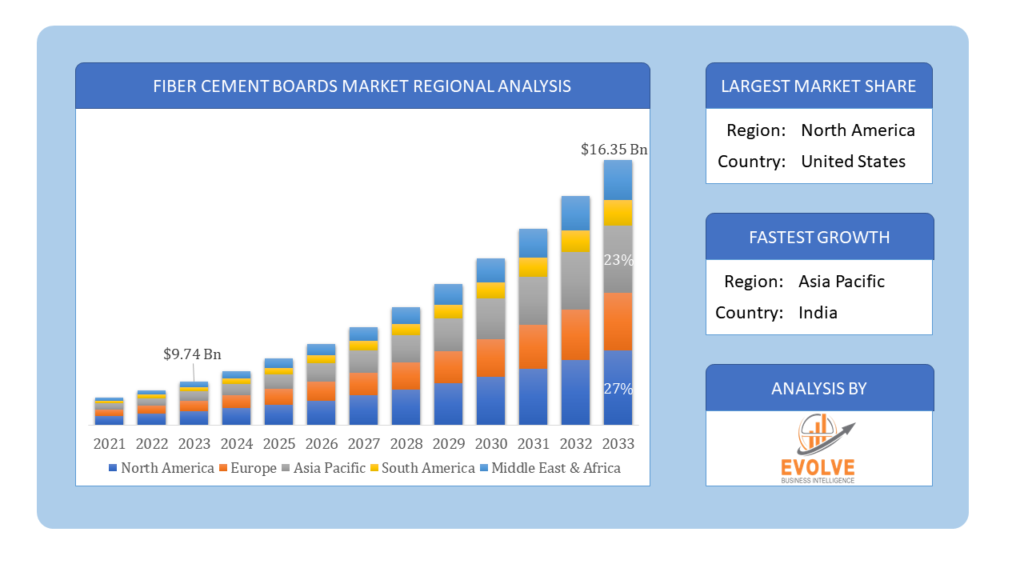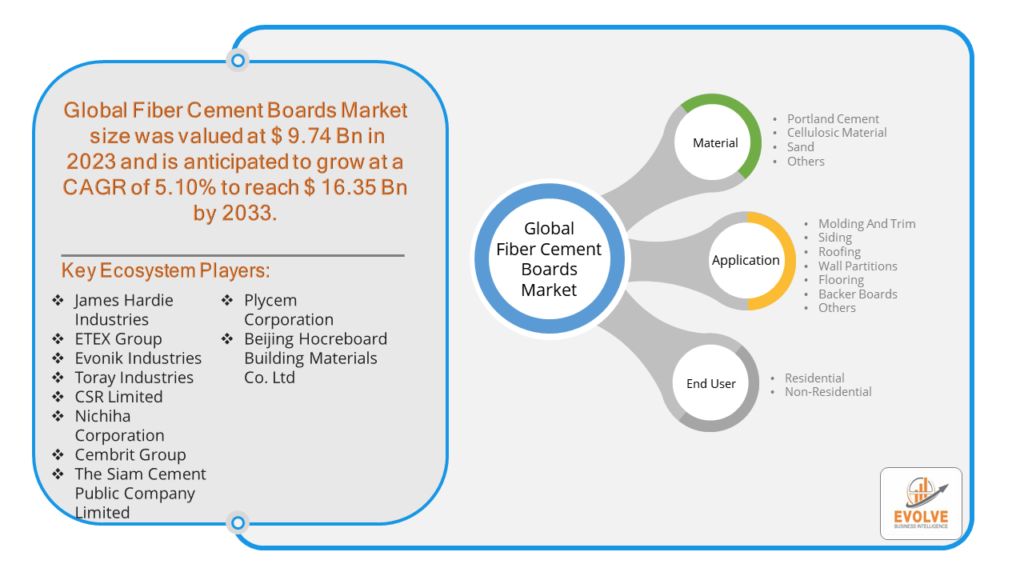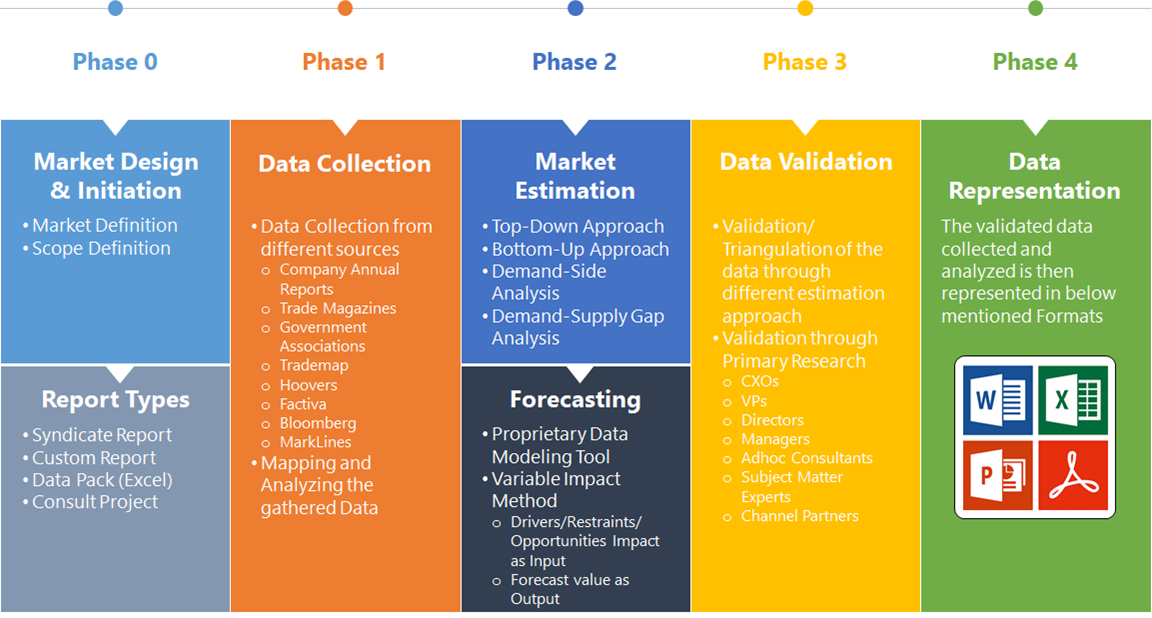Fiber Cement Boards Market Overview
The Fiber Cement Boards Market Size is expected to reach USD 16.35 Billion by 2033. The Fiber Cement Boards Market industry size accounted for USD 9.74 Billion in 2023 and is expected to expand at a compound annual growth rate (CAGR) of 5.10% from 2023 to 2033. The Fiber Cement Boards Market refers to the industry involved in the production, distribution, and sale of fiber cement boards. Fiber cement boards are composite building materials made of cement reinforced with cellulose fibers, which enhances their durability and strength. These boards are widely used in construction for both residential and commercial buildings due to their resistance to fire, moisture, termites, and rot, as well as their versatility in design and application.
The Fiber Cement Boards Market is expected to grow significantly due to the increasing demand for durable and low-maintenance building materials, coupled with the rise in construction activities globally.
Global Fiber Cement Boards Market Synopsis
The COVID-19 pandemic had a significant impact on the Fiber Cement Boards Market. Lockdowns and restrictions led to the temporary closure of manufacturing facilities, causing delays in production. Many construction projects were put on hold or delayed due to lockdowns and economic uncertainty. Increased demand for materials that are easy to clean and maintain, such as fiber cement boards, due to their low maintenance and durability. With more people spending time at home, there was a rise in home renovation and improvement projects, leading to increased demand for building materials. Post-pandemic, there is likely to be an increased emphasis on sustainable and eco-friendly building materials, driving demand for fiber cement boards. As economies recover and construction activities resume, the fiber cement boards market is expected to regain momentum.
Fiber Cement Boards Market Dynamics
The major factors that have impacted the growth of Fiber Cement Boards Market are as follows:
Drivers:
Ø Technological Advancements
Advances in manufacturing processes have improved the quality and performance of fiber cement boards, making them more competitive with traditional materials. Continuous product innovation, including enhanced aesthetic options and improved performance characteristics, is driving market demand. The trend of home renovations and remodeling, particularly in developed regions, is increasing the demand for fiber cement boards. Businesses and institutions are also investing in upgrading their facilities, contributing to market growth.
Restraint:
- Perception of High Initial Cost
Fiber cement boards are generally more expensive than traditional materials like wood, vinyl, and other siding options, which can deter cost-conscious builders and homeowners. The higher initial investment required for purchasing and installing fiber cement boards can be a barrier for some projects, particularly in cost-sensitive markets. Cutting fiber cement boards generates silica dust, which poses health risks if inhaled. Proper safety measures, including the use of protective equipment and adequate ventilation, are necessary during installation.
Opportunity:
⮚ Growing demand for Eco-Friendly Construction
Increasing awareness and demand for sustainable and eco-friendly building materials provide a significant opportunity for fiber cement boards, which are known for their durability and low environmental impact. As more builders and developers aim to achieve green building certifications (such as LEED), the demand for materials like fiber cement boards, which contribute to energy efficiency and sustainability, is expected to rise. As the frequency and intensity of natural disasters increase, there is a growing need for building materials that offer resilience against extreme weather conditions. Fiber cement boards, known for their durability and resistance to elements, are well-positioned to meet this demand. Supportive regulations and incentives for using disaster-resilient materials in construction can further drive the adoption of fiber cement boards.
Fiber Cement Boards Market Segment Overview
By Material
 Based on Material, the market is segmented based on Portland Cement, Cellulosic Material, Sand and Others. The Portland cement segment dominated the market due to its widely used binding agent in Fiber Cement Board production. Portland cement offers remarkable strength, durability, and resistance to fire, moisture, and pests. It ensures the structural integrity of Fiber Cement Boards by providing excellent adhesion to reinforcing fibers. Moreover, the versatility of Portland Cement allows manufacturers to customize Fiber Cement Boards by incorporating different raw materials and additives, catering to specific requirements.
Based on Material, the market is segmented based on Portland Cement, Cellulosic Material, Sand and Others. The Portland cement segment dominated the market due to its widely used binding agent in Fiber Cement Board production. Portland cement offers remarkable strength, durability, and resistance to fire, moisture, and pests. It ensures the structural integrity of Fiber Cement Boards by providing excellent adhesion to reinforcing fibers. Moreover, the versatility of Portland Cement allows manufacturers to customize Fiber Cement Boards by incorporating different raw materials and additives, catering to specific requirements.
By Application
Based on Application, the market segment has been divided into the Molding And Trim, Siding, Roofing, Wall Partitions, Flooring, Backer Boards and Others. The siding segment dominated the market. The growth of the segment is attributed to the increasing use of siding fiber cement for the increasing exterior look of the building. Fiber cement siding is the lower maintenance exterior of residential and non-residential buildings. Siding protects and helps to maintain the building from the exterior elements. Siding is a major application or type of fiber cement in both the residential and non-residential sectors.
By End User
Based on End User, the market segment has been divided into the Residential and Non-Residential. The residential buildings segment dominated the market. fiber cement boards are resistant to moisture, rot, and pests, ensuring long-term performance and reliability in residential structures. They also provide excellent thermal insulation and are highly fire-resistant, contributing to residential buildings’ safety and energy efficiency. Moreover, fiber cement boards offer versatility in design options and color choices, allowing homeowners to achieve their desired aesthetics.
Global Fiber Cement Boards Market Regional Analysis
Based on region, the global Fiber Cement Boards Market has been divided into North America, Europe, Asia-Pacific, the Middle East & Africa, and Latin America. North America is projected to dominate the use of the Fiber Cement Boards Market followed by the Asia-Pacific and Europe regions.
 Fiber Cement Boards North America Market
Fiber Cement Boards North America Market
North America holds a dominant position in the Fiber Cement Boards Market. North America had high demand due to stringent building codes and regulations emphasizing fire resistance and durability. Strong presence of major market players and advanced manufacturing facilities. Increasing trend of home renovations and remodeling and rising awareness of sustainable and energy-efficient building materials.
Fiber Cement Boards Asia-Pacific Market
The Asia-Pacific region has indeed emerged as the fastest-growing market for the Fiber Cement Boards Market industry. Asia-Pacific region is rapidly growing market due to urbanization and industrialization. Significant investments in infrastructure development in emerging economies and Increasing awareness of the benefits of fiber cement boards.
Competitive Landscape
The global Fiber Cement Boards Market is highly competitive, with numerous players offering a wide range of software solutions. The competitive landscape is characterized by the presence of established companies, as well as emerging startups and niche players. To increase their market position and attract a wide consumer base, the businesses are employing various strategies, such as product launches, and strategic alliances.
Prominent Players:
- James Hardie Industries
- ETEX Group
- Evonik Industries
- Toray Industries
- CSR Limited
- Nichiha Corporation
- Cembrit Group
- The Siam Cement Public Company Limited
- Plycem Corporation
- Beijing Hocreboard Building Materials Co. Ltd
Key Development
In June 2022, Swisspearl Group has recently made an announcement regarding its acquisition of Cembrit. This strategic decision was undertaken by the Swisspearl Group with the aim of expanding its presence in the international market and strengthening its portfolio of production sites.
Scope of the Report
Global Fiber Cement Boards Market, by Material
- Portland Cement
- Cellulosic Material
- Sand
- Others
Global Fiber Cement Boards Market, by Application
- Molding And Trim
- Siding
- Roofing
- Wall Partitions
- Flooring
- Backer Boards
- Others
Global Fiber Cement Boards Market, by End User
- Residential
- Non-Residential
Global Fiber Cement Boards Market, by Region
- North America
- US
- Canada
- Mexico
- Europe
- UK
- Germany
- France
- Italy
- Spain
- Benelux
- Nordic
- Rest of Europe
- Asia Pacific
- China
- Japan
- South Korea
- Indonesia
- Austalia
- Malaysia
- India
- Rest of Asia Pacific
- South America
- Brazil
- Argentina
- Rest of South America
- Middle East & Africa
- Saudi Arabia
- UAE
- Egypt
- South Africa
- Rest of Middle East & Africa
| Parameters | Indicators |
|---|---|
| Market Size | 2033: $16.35 Billion |
| CAGR | 5.10% CAGR (2023-2033) |
| Base year | 2022 |
| Forecast Period | 2023-2033 |
| Historical Data | 2021 |
| Report Coverage | Revenue Forecast, Competitive Landscape, Growth Factors, and Trends |
| Key Segmentations | Material, Application, End User |
| Geographies Covered | North America, Europe, Asia-Pacific, Latin America, Middle East, Africa |
| Key Vendors | James Hardie Industries, ETEX Group, Evonik Industries, Toray Industries, CSR Limited, Nichiha Corporation, Cembrit Group, The Siam Cement Public Company Limited, Plycem Corporation and Beijing Hocreboard Building Materials Co. Ltd |
| Key Market Opportunities | • Growing demand for Eco-Friendly Construction • Increasing Focus on Disaster-Resilient Construction |
| Key Market Drivers | • Technological Advancements • Renovation and Remodeling Trends |
REPORT CONTENT BRIEF:
- High-level analysis of the current and future Fiber Cement Boards Market trends and opportunities
- Detailed analysis of current market drivers, restraining factors, and opportunities in the future
- Fiber Cement Boards Market historical market size for the year 2021, and forecast from 2023 to 2033
- Fiber Cement Boards Market share analysis at each product level
- Competitor analysis with detailed insight into its product segment, Government & Defense strength, and strategies adopted.
- Identifies key strategies adopted including product launches and developments, mergers and acquisitions, joint ventures, collaborations, and partnerships as well as funding taken and investment done, among others.
- To identify and understand the various factors involved in the global Fiber Cement Boards Market affected by the pandemic
- To provide a detailed insight into the major companies operating in the market. The profiling will include the Government & Defense health of the company’s past 2-3 years with segmental and regional revenue breakup, product offering, recent developments, SWOT analysis, and key strategies.





